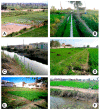Very High Fascioliasis Intensities in Schoolchildren from Nile Delta Governorates, Egypt: The Old World Highest Burdens Found in Lowlands
- PMID: 34578242
- PMCID: PMC8470878
- DOI: 10.3390/pathogens10091210
Very High Fascioliasis Intensities in Schoolchildren from Nile Delta Governorates, Egypt: The Old World Highest Burdens Found in Lowlands
Abstract
Quantitative coprological analyses of children were performed in Alexandria and Behera governorates, Egypt, to ascertain whether individual intensities in the Nile Delta lowlands reach high levels as those known in hyperendemic highland areas of Latin America. Analyses focused on subjects presenting intensities higher than 400 eggs per gram of faeces (epg), the high burden cut-off according to WHO classification. A total of 96 children were found to shed between 408 and 2304 epg, with arithmetic and geometric means of 699.5 and 629.07 epg, respectively. Intensities found are the highest hitherto recorded in Egypt, and also in the whole Old World. A total of 38 (39.6%) were males and 58 (60.4%) were females, with high intensities according to gender following a negative binomial distribution. The high burden distribution shows a peak in the 7-10 year-old children group, more precocious in females than males. Results showed high burdens in winter to be remarkably higher than those known in summer. The fascioliasis scenario in Egyptian lowlands shows similarities to highlands of Bolivia and Peru. Diagnostic methods, pathogenicity and morbidity in high burdens should be considered. The need for an appropriate quantitative assessment of heavy infected children to avoid post-treatment colic episodes is highlighted.
Keywords: Alexandria and Behera governorates; Egypt; Nile Delta; children; coprology; gender and age; geographical distribution; high intensities; human fascioliasis.
Conflict of interest statement
The authors declare no conflict of interest. The funders had no role in the design of the study; in the collection, analyses, or interpretation of data; in the writing of the manuscript; or in the decision to publish the results.
Figures







References
-
- Mas-Coma S., Valero M.A., Bargues M.D. Fasciola, lymnaeids and human fascioliasis, with a global overview on disease transmission, epidemiology, evolutionary genetics, molecular epidemiology and control. Adv. Parasitol. 2009;69:41–146. - PubMed
-
- Bargues M.D., Artigas P., Mera y Sierra R., Pointier J.P., Mas-Coma S. Characterisation of Lymnaea cubensis, L. viatrix and L. neotropica n. sp., the main vectors of Fasciola hepatica in Latin America, by analysis of their ribosomal and mitochondrial DNA. Ann. Trop. Med. Parasitol. 2007;101:621–641. doi: 10.1179/136485907X229077. - DOI - PubMed
-
- Bargues M.D., Artigas P., Khoubbane M., Flores R., Glöer P., Rojas-Garcia R., Ashrafi K., Falkner G., Mas-Coma S. Lymnaea schirazensis, an overlooked snail distorting fascioliasis data: Genotype, phenotype, ecology, worldwide spread, susceptibility, applicability. PLoS ONE. 2011;6:e24567. doi: 10.1371/journal.pone.0024567. - DOI - PMC - PubMed
-
- Afshan K., Fortes-Lima C.A., Artigas P., Valero M.A., Qayyum M., Mas-Coma S. Impact of climate change and man-made irrigation systems on the transmission risk, long-term trend and seasonality of human and animal fascioliasis in Pakistan. Geospat. Health. 2014;8:317–334. doi: 10.4081/gh.2014.22. - DOI - PubMed
Grants and funding
- SAF2006-09278 and No. SAF2010-20805/Ministry of Science and Technology, Madrid, Spain
- BOS2002-01978/Ministry of Education . Madrid, Spain
- PI030545/Ministry of Health, Madrid, Spain
- C03/04, ISCIII2005-PI050574 and ISCIII-RETIC RD06/0021/0017/Programme of Redes Temáticas de Investigación Cooperativa RETICS/FEDER), FIS, Ministry of Health, Madrid, Spain
- AID No. 3703/Ministry of Health and Population (MoHP), Egypt and the Directorate General for Cooperation and Development (DGCS), Ministry of Foreign Af-fairs, Italy
LinkOut - more resources
Full Text Sources

